Ranges Improvements with C++23
Thanks to C++23, constructing containers will become more convenient. Additionally, the ranges library got more new views.

Ranges
C++23 is not such a significant standard as C++11 or C++20. It’s more in the tradition of C++17. This is mainly due to COVID-19 because the annual four face-to-face meetings went online. Essentially, the ranges library is the exception to this rule. The ranges will get a few crucial additions.
If you know more details about what you can expect about C++23 (before I write about it), study cppreference.com/compiler_support. Even better, read the excellent paper from Steve Downey (C++23 Status Report).
Constructing Containers
Constructing a container from a range was a complicated job. The following function range simulates python2’s range function. Python2’s range function is eager, and so is its range pendant: Additionally, Pythons range function returns a list, but mine a std::vector.
// range.cpp #include <iostream> #include <range/v3/all.hpp> #include <vector> std::vector<int> range(int begin, int end, int stepsize = 1) { std::vector<int> result{}; if (begin < end) { // (5) auto boundary = [end](int i){ return i < end; }; for (int i: ranges::views::iota(begin) | ranges::views::stride(stepsize) | ranges::views::take_while(boundary)) { result.push_back(i); } } else { // (6) begin++; end++; stepsize *= -1; auto boundary = [begin](int i){ return i < begin; }; for (int i: ranges::views::iota(end) | ranges::views::take_while(boundary) | ranges::views::reverse | ranges::views::stride(stepsize)) { result.push_back(i); } } return result; } int main() { std::cout << std::endl; // range(1, 50) // (1) auto res = range(1, 50); for (auto i: res) std::cout << i << " "; std::cout << "\n\n"; // range(1, 50, 5) // (2) res = range(1, 50, 5); for (auto i: res) std::cout << i << " "; std::cout << "\n\n"; // range(50, 10, -1) // (3) res = range(50, 10, -1); for (auto i: res) std::cout << i << " "; std::cout << "\n\n"; // range(50, 10, -5) // (4) res = range(50, 10, -5); for (auto i: res) std::cout << i << " "; std::cout << "\n\n"; }
 Modernes C++ Mentoring
Modernes C++ Mentoring
Do you want to stay informed: Subscribe.
The calls in lines (1) – (4) should be pretty easy to read when looking at the output.

The first two arguments of the range call stand for the beginning and end of the created integers. The begin is included but not the end. The step size as the third parameter is, per default, 1. The step size should be negative when the interval [begin, end] decreases. If not, you get an empty list or an empty std::vector<int>.
I cheat a little in my range implementation. I use the function ranges::views::stride, which is not part of C++20. stride(n) returns the n-th element of the given range. I assume that std::views::stride becomes part of C++23, but I’m not sure. Consequentially, I used the ranges v3 implementation in my example but not the C++20 implementation of the ranges library.
The if condition (begin < end) of the range function in line (1) should be quite easy to read. Create all numbers starting with begin (ranges::views::iota(begin)), take each n-th element (ranges::views::stride(stepsize), and do it as long as the boundary condition holds (ranges::views::take_while(boundary). Finally, push the integers on the std::vector<int>.
I use a little trick in the other case (line 2). I create the numbers [end++, begin++[, take them until the boundary condition is met, reverse them (ranges::views::reverse), and take each n-th element.
Now, let’s assume that std::views::stride is part of C++23. Thanks to std::ranges::to, it’s pretty easy to construct a Container. Here is the C++23-based implementation of the previous range function.
std::vector<int> range(int begin, int end, int stepsize = 1) { std::vector<int> result{}; if (begin < end) { auto boundary = [end](int i){ return i < end; }; result = std::ranges::views::iota(begin) | std::views::stride(stepsize) | std::views::take_while(boundary) | std::ranges::to<std::vector>(); } else { begin++; end++; stepsize *= -1; auto boundary = [begin](int i){ return i < begin; }; result = std::ranges::views::iota(end) | std::views::take_while(boundary) | std::views::reverse | std::views::stride(stepsize) | std::ranges::to<std::vector>(); } return result; }
Essentially, I replaced the push_back operation on the std::vector with the new call std::ranges::to<std::vector>, and got rid of two lines of code. So far, no compiler supports this new convenient function to create a container. I created the new range function based on my interpretation of the specification. If there is an error included, I will fix it.
Existing Algorithms in C++20
Before I show you the new views in C++23, here are the already existing ones in C++20:
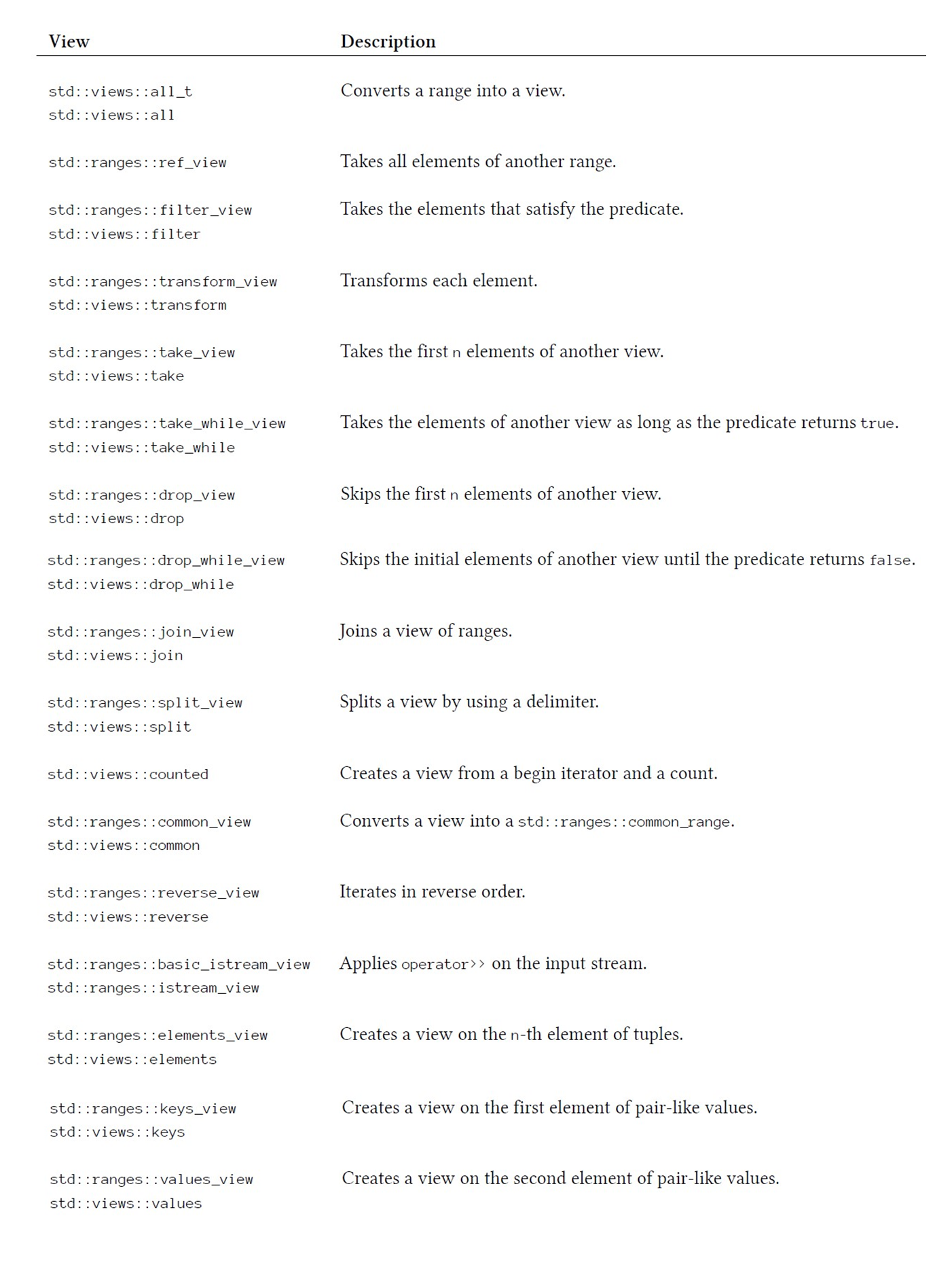
New Views in C++23
Now, I want to present to you the new views. If possible, I will provide you with a short code example.
std::ranges::views::zip_transform,andstd::views::zip_transform
Creates a view that consists of tuples by applying a transformation function.
Here is an excellent example from cppreferene.com/zip_transform_view:
#include <list> #include <array> #include <ranges> #include <vector> #include <iostream> void print(auto const rem, auto const& r) { for (std::cout << rem; auto const& e : r) std::cout << e << ' '; std::cout << '\n'; } int main() { auto v1 = std::vector<float>{1, 2, 3}; auto v2 = std::list<short>{1, 2, 3, 4}; auto v3 = std::to_array({1, 2, 3, 4, 5}); auto add = [](auto a, auto b, auto c) { return a + b + c; }; auto sum = std::views::zip_transform(add, v1, v2, v3); print("v1: ", v1); // 1 2 3 print("v2: ", v2); // 1 2 3 4 print("v3: ", v3); // 1 2 3 4 5 print("sum: ", sum); // 3 6 9 }
I added the output directly into the source code.
std::ranges::adjacent_view,std::views::adjacent_view, std::ranges::adjacent_transform_view,andstd::views::adjacent_transform
Creates a view that consists of tuples of references to adjacent elements. Additionally, You can apply a transformation function.
These examples are directly from the proposal P2321R2:
vector v = {1, 2, 3, 4}; for (auto i : v | views::adjacent<2>) { cout << '(' << i.first << ', ' << i.second << ") "; // prints: (1, 2) (2, 3) (3, 4) } for (auto i : v | views::adjacent_transform<2>(std::multiplies())) { cout << i << ' '; // prints: 2 6 12 }
std::ranges::join_with,andstd::views::join_with
Creates a view by flattening the input range. Puts a delimiter between elements.
cppreference.com/join_with_view provides a nice example in which a space is the delimiter element.
#include <iostream> #include <ranges> #include <vector> #include <string_view> int main() { using namespace std::literals; std::vector v{"This"sv, "is"sv, "a"sv, "test."sv}; auto joined = v | std::views::join_with(' '); for (auto c : joined) std::cout << c; std::cout << '\n'; }
std::views::chunk,andstd::views::chunk_by
Creates a view by dividing a range R into non-overlapping N-sized chunks. Additionally, you can apply a predicate.
The code snippets are from proposal P2442R1 and proposal P2443R1.
std::vector v = {1, 2, 3, 4, 5}; fmt::print("{}\n", v | std::views::chunk(2)); // [[1, 2], [3, 4], [5]] fmt::print("{}\n", v | std::views::slide(2)); // [[1, 2], [2, 3], [3, 4], [4, 5]] std::vector v = {1, 2, 2, 3, 0, 4, 5, 2}; fmt::print("{}\n", v | std::views::chunk_by(ranges::less_equal{})); // [[1, 2, 2, 3], [0, 4, 5], [2]]
Both code snippets use the prototype library fmt for the format library in C++20. fmt has a convenience function fmt::print that may become part of C++23 as std::print.
std::views::slide
Creates a view of N-tuples by taking a view and a number N.
The example is also from proposal P2443R1.
vector v = {1, 2, 3, 4}; for (auto i : v | views::slide(2)) { cout << '[' << i[0] << ', ' << i[1] << "] "; // prints: [1, 2] [2, 3] [3, 4] }
What’s next?
Last week, I made a poll and asked: “Which mentoring program should I implement next?” Honestly, this result surprised me a lot. I taught Design Patterns from 2004 to 2008 and assumed that you already knew them, and C++20 or Clean Code with C++ would win the poll. Consequentially, I changed my plan for my upcoming posts. My next big topic will be “Design Pattern and Architectural Pattern in C++”. When I finish this big topic, I will return to C++20 and C++23.
Thanks a lot to my Patreon Supporters: Matt Braun, Roman Postanciuc, Tobias Zindl, G Prvulovic, Reinhold Dröge, Abernitzke, Frank Grimm, Sakib, Broeserl, António Pina, Sergey Agafyin, Андрей Бурмистров, Jake, GS, Lawton Shoemake, Jozo Leko, John Breland, Venkat Nandam, Jose Francisco, Douglas Tinkham, Kuchlong Kuchlong, Robert Blanch, Truels Wissneth, Mario Luoni, Friedrich Huber, lennonli, Pramod Tikare Muralidhara, Peter Ware, Daniel Hufschläger, Alessandro Pezzato, Bob Perry, Satish Vangipuram, Andi Ireland, Richard Ohnemus, Michael Dunsky, Leo Goodstadt, John Wiederhirn, Yacob Cohen-Arazi, Florian Tischler, Robin Furness, Michael Young, Holger Detering, Bernd Mühlhaus, Stephen Kelley, Kyle Dean, Tusar Palauri, Juan Dent, George Liao, Daniel Ceperley, Jon T Hess, Stephen Totten, Wolfgang Fütterer, Matthias Grün, Ben Atakora, Ann Shatoff, Rob North, Bhavith C Achar, Marco Parri Empoli, Philipp Lenk, Charles-Jianye Chen, Keith Jeffery, Matt Godbolt, Honey Sukesan, bruce_lee_wayne, Silviu Ardelean, schnapper79, Seeker, and Sundareswaran Senthilvel.
Thanks, in particular, to Jon Hess, Lakshman, Christian Wittenhorst, Sherhy Pyton, Dendi Suhubdy, Sudhakar Belagurusamy, Richard Sargeant, Rusty Fleming, John Nebel, Mipko, Alicja Kaminska, Slavko Radman, and David Poole.
| My special thanks to Embarcadero |  |
| My special thanks to PVS-Studio |  |
| My special thanks to Tipi.build |  |
| My special thanks to Take Up Code |  |
| My special thanks to SHAVEDYAKS | 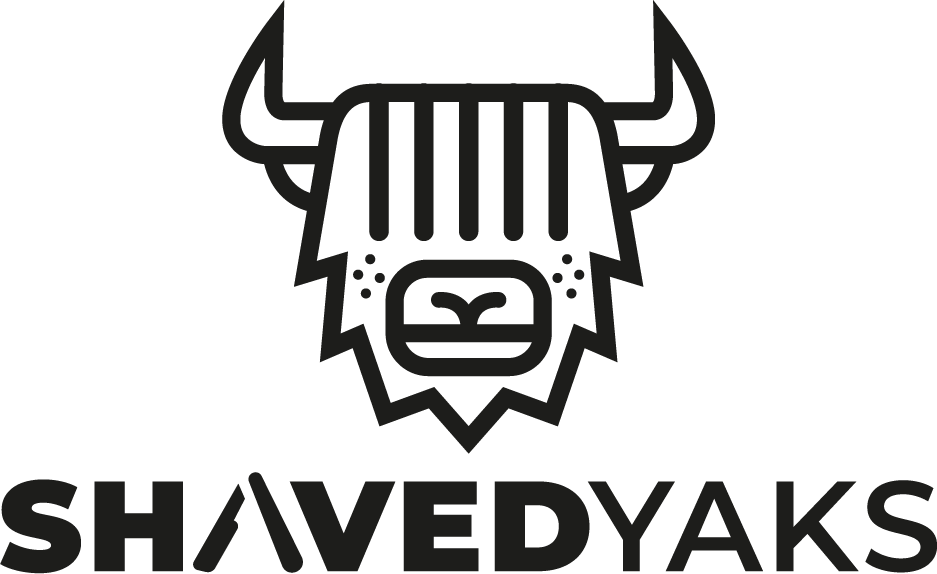 |
Modernes C++ GmbH
Modernes C++ Mentoring (English)
Rainer Grimm
Yalovastraße 20
72108 Rottenburg
Mail: schulung@ModernesCpp.de
Mentoring: www.ModernesCpp.org




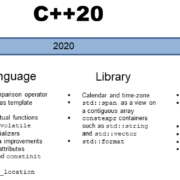

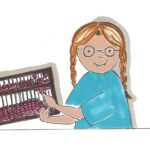
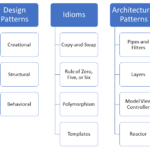
Leave a Reply
Want to join the discussion?Feel free to contribute!